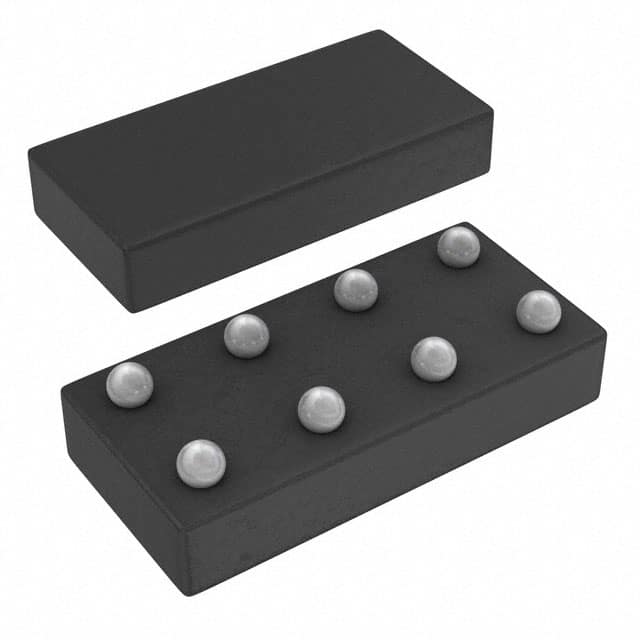Lihat spesifikasi untuk detail produk.

SN74LVC3G06YEAR
Basic Information Overview
- Category: Integrated Circuit (IC)
- Use: Logic Gate Buffer/Inverter
- Characteristics: Low Voltage, High-Speed, Triple Inverter
- Package: SOT-23-5
- Essence: A small-sized integrated circuit that provides buffering and inverting functions for digital signals.
- Packaging/Quantity: Available in reels of 3000 units.
Specifications
- Supply Voltage Range: 1.65V to 5.5V
- Input Voltage Range: 0V to VCC
- Output Voltage Range: 0V to VCC
- Maximum Operating Frequency: 100 MHz
- Propagation Delay: 2.6 ns (typical)
- Input Capacitance: 3 pF (typical)
- Output Drive Capability: ±24 mA
Detailed Pin Configuration
The SN74LVC3G06YEAR has a total of five pins: 1. GND: Ground reference for the IC. 2. IN: Input pin for the logic signal. 3. OUT: Output pin for the buffered/inverted logic signal. 4. VCC: Positive supply voltage pin. 5. NC: No connection pin.
Functional Features
- Triple Inverter: The IC contains three independent inverters, allowing it to buffer or invert up to three different logic signals simultaneously.
- High-Speed Operation: With a maximum operating frequency of 100 MHz, the SN74LVC3G06YEAR can handle high-speed digital signals effectively.
- Low Voltage Operation: The IC operates at a low supply voltage range of 1.65V to 5.5V, making it suitable for battery-powered devices and low-power applications.
- Schmitt Trigger Inputs: The inputs of the IC are equipped with Schmitt trigger hysteresis, ensuring reliable operation even in the presence of noisy or slow-changing input signals.
- ESD Protection: The IC incorporates built-in electrostatic discharge (ESD) protection, safeguarding it against damage from static electricity.
Advantages and Disadvantages
Advantages: - Small Package Size: The SOT-23-5 package allows for compact circuit designs, making it suitable for space-constrained applications. - High-Speed Operation: The IC's fast propagation delay enables efficient signal processing in time-critical applications. - Low Power Consumption: Operating at low voltages, the SN74LVC3G06YEAR minimizes power consumption, extending battery life in portable devices.
Disadvantages: - Limited Output Drive Capability: The IC has a maximum output drive capability of ±24 mA, which may not be sufficient for driving heavy loads or long transmission lines. - Single Logic Function: The IC only provides buffering and inverting functions, limiting its versatility compared to more complex logic gates.
Working Principles
The SN74LVC3G06YEAR operates based on the principles of complementary metal-oxide-semiconductor (CMOS) technology. It utilizes a combination of NMOS and PMOS transistors to achieve the desired buffering and inverting functionality. When an input logic signal is applied, the internal circuitry amplifies and inverts the signal, providing the corresponding buffered/inverted output.
Detailed Application Field Plans
The SN74LVC3G06YEAR finds applications in various digital systems, including but not limited to: 1. Microcontrollers and Microprocessors: Providing level shifting and signal conditioning between different voltage domains. 2. Communication Systems: Buffering and inverting digital signals in data transmission and reception circuits. 3. Consumer Electronics: Signal inversion for audio amplifiers, video processing, and display drivers. 4. Industrial Automation: Interface conversion and signal conditioning in control systems and sensor interfaces. 5. Automotive Electronics: Level shifting and signal buffering in automotive control units and infotainment systems.
Detailed and Complete Alternative Models
- SN74LVC3G07: Similar to SN74LVC3G06YEAR, but with open-drain outputs instead of push-pull outputs.
- SN74LVC3G04: Triple Inverter IC with Schmitt trigger inputs for improved noise immunity.
- SN74LVC3G34: Triple Buffer/Inverter IC with higher output drive capability (+/- 32 mA) and wider supply voltage range (1.65V to 5.5V).
(Note: The above alternative models are suggestions and not an exhaustive list.)
This entry provides a comprehensive overview of the SN74LVC3G06YEAR integrated circuit, including its basic information, specifications, pin configuration, functional features, advantages, disadvantages, working principles, application field plans, and alternative models.
Sebutkan 10 pertanyaan dan jawaban umum terkait penerapan SN74LVC3G06YEAR dalam solusi teknis
Sure! Here are 10 common questions and answers related to the application of SN74LVC3G06YEAR in technical solutions:
Q: What is SN74LVC3G06YEAR? A: SN74LVC3G06YEAR is a triple inverter gate with open-drain outputs, commonly used in digital logic circuits.
Q: What is the voltage range supported by SN74LVC3G06YEAR? A: SN74LVC3G06YEAR supports a voltage range from 1.65V to 5.5V.
Q: What is the maximum output current of SN74LVC3G06YEAR? A: The maximum output current of SN74LVC3G06YEAR is typically 32mA.
Q: Can SN74LVC3G06YEAR be used for level shifting applications? A: Yes, SN74LVC3G06YEAR can be used for level shifting between different voltage domains.
Q: Does SN74LVC3G06YEAR have built-in protection features? A: Yes, SN74LVC3G06YEAR has built-in ESD (Electrostatic Discharge) protection on its inputs and outputs.
Q: What is the propagation delay of SN74LVC3G06YEAR? A: The propagation delay of SN74LVC3G06YEAR is typically around 3.8ns.
Q: Can SN74LVC3G06YEAR drive capacitive loads? A: Yes, SN74LVC3G06YEAR can drive capacitive loads up to 50pF.
Q: Is SN74LVC3G06YEAR suitable for battery-powered applications? A: Yes, SN74LVC3G06YEAR is suitable for battery-powered applications due to its low power consumption.
Q: Can SN74LVC3G06YEAR be used in high-speed data transmission? A: Yes, SN74LVC3G06YEAR can be used in high-speed data transmission up to several hundred megabits per second.
Q: What package options are available for SN74LVC3G06YEAR? A: SN74LVC3G06YEAR is available in various package options, such as SOT-23 and VSSOP, providing flexibility in board design.
Please note that the answers provided here are general and may vary depending on specific datasheet specifications and application requirements.

